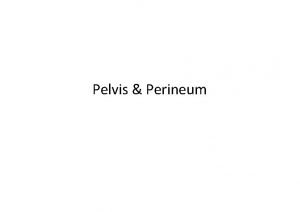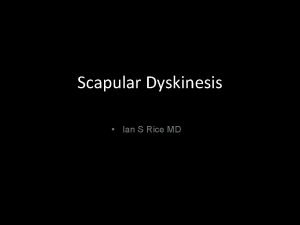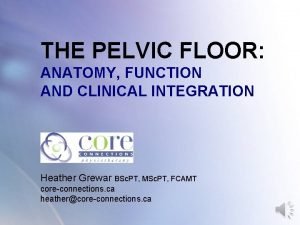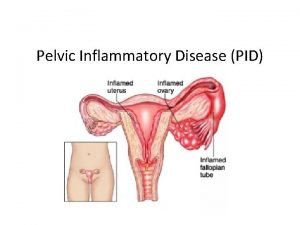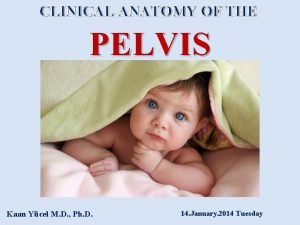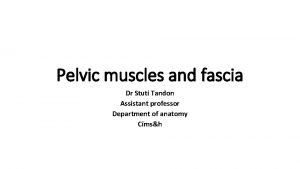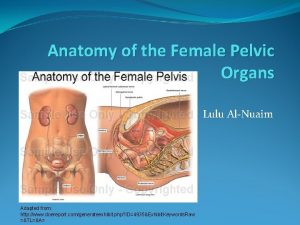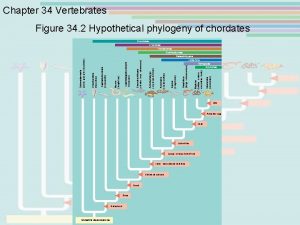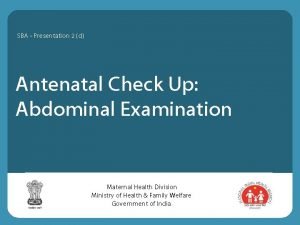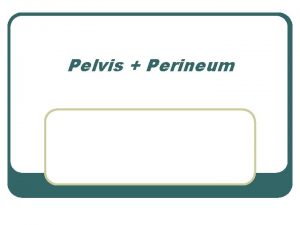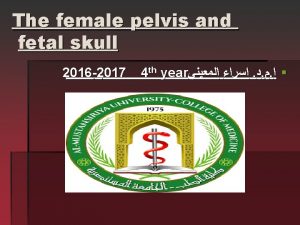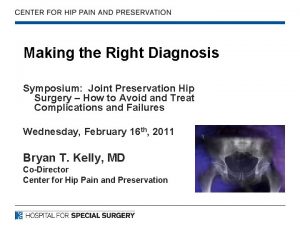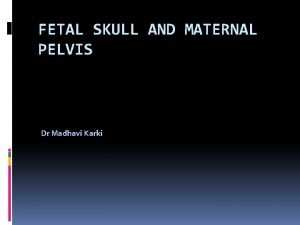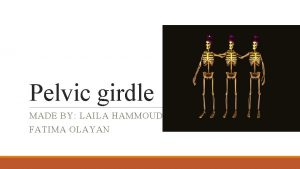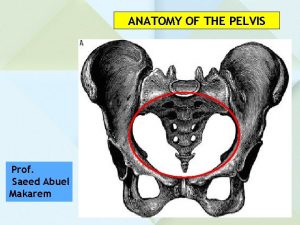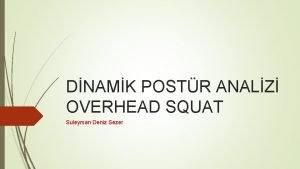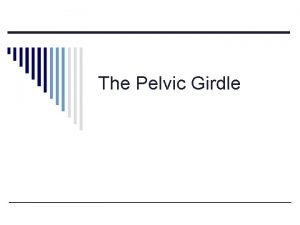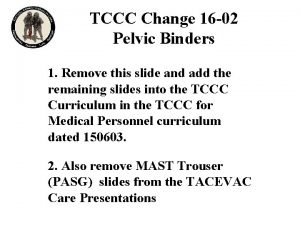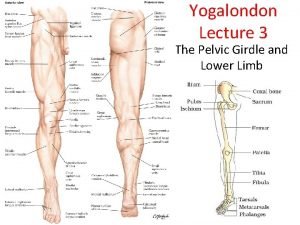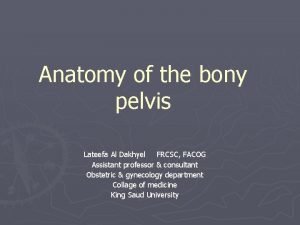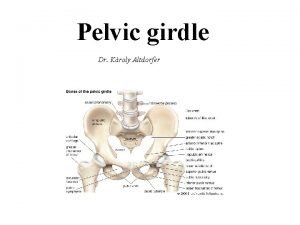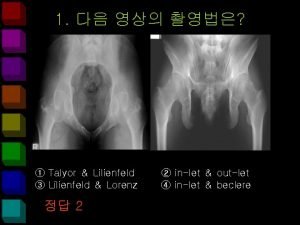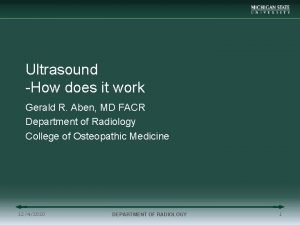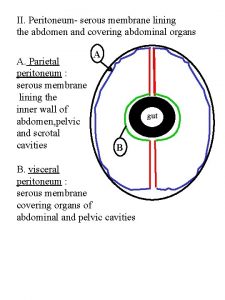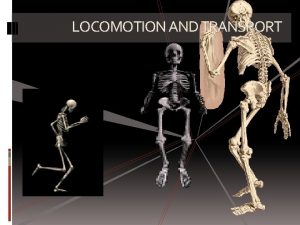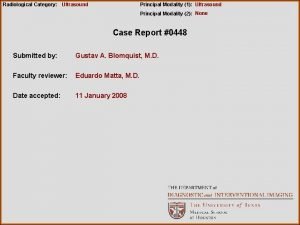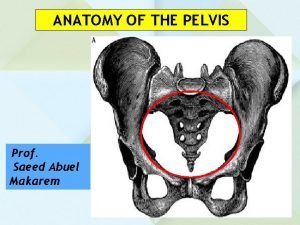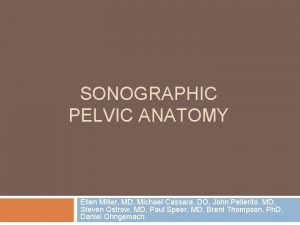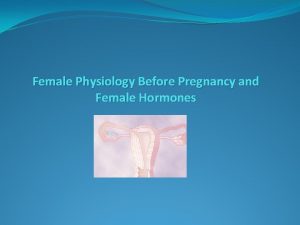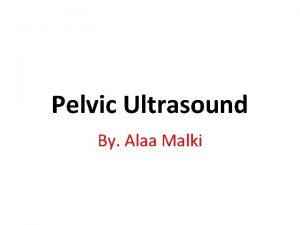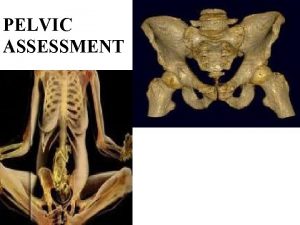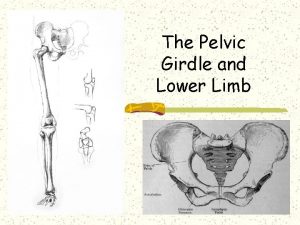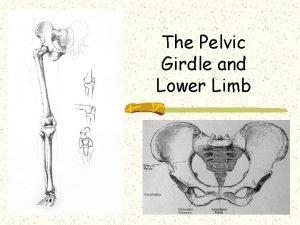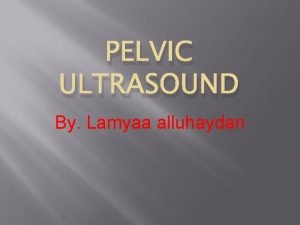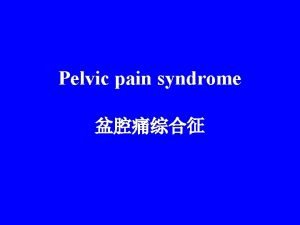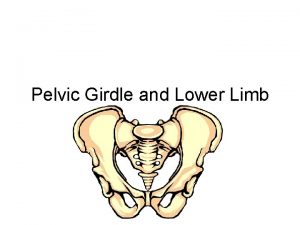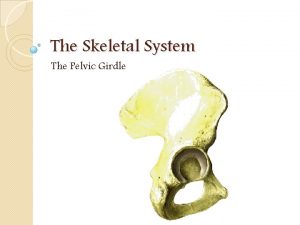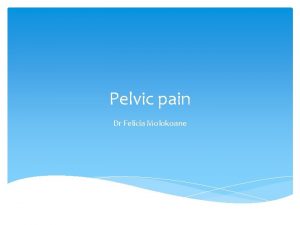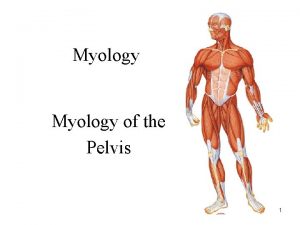Sonographic Imaging of the Female Patient with Pelvic


































































- Slides: 66

Sonographic Imaging of the Female Patient with Pelvic Pain/ Bleeding Sarah A. Stahmer MD Cooper Hospital/University Medical Center

Case Presentation l 24 yo female presents with missed period, cramping, midline abdominal pain and spotting l VS: BP 120/80 HR 110 l Pelvic: – Cervical os is closed with minimal bleeding – No CMT, adenexa symmetric l Urine h. CG is +

Case presentation l l l A bedside ultrasound is performed The US reveals an IUP The patient is discharged to home with threatened abortion precautions LOS = 30 minutes Applies to 60% of pts

Role of Bedside Sonography l Identify an IUP l Establish fetal viability

Secondary Indications l Hemodynamic l Trauma and pregnancy l Localization l Identify instability in a female pt of IUD/foreign body sources of pelvic pain in nonpregnant patients

Imaging: Transabdominal Uses a lower frequency transducer: 3. 5 – 5 m. Hz l Better penetration, larger field of view l It should be the initial imaging window to assess for l – Advanced IUP – Fibroids/masses – Pelvic fluid l The bladder should be full to provide an acoustic window

Endovaginal Uses a higher frequency transducer: 6. 0 -7. 5 m. Hz l Provides optimal imaging of: l – Endometrium – Myometrium – Cul-de-sac – Ovaries A full bladder is not necessary for this approach l Is usually better tolerated by patients l

Scanning Protocol: Transabdominal l Image the patient before obtaining a urine sample l Can fill the bladder via foley and instill 300 cc NS but… l If the bladder is empty, go directly to TV imaging after the pelvic exam

Probe Selection l “Workhorse”probe l 3. 5 to 5. 0 MHz l Multi-frequency probe l Good for most cardiac/abdominal applications

Uterus l An oval organ located superior to the full bladder l The maximum size of the non-gravid uterus is 5 -7 cm x 4 -5 cm l The endometrial stripe is the opposed surfaces of the endometrial cavity

Transabdominal / Transverse view Right Left

Cul-de-sac l Located posterior to the uterus and upper vagina l A small amount of fluid may be seen in mid cycle l A small amount of fluid in the posterior cul-de-sac may be the only sonographic finding in EP

Bladder uterus

Probe Selection l Endovaginal Probe l 5 to 8 m. Hz variable frequency probe l Up to 180 degree angle of view

Endovaginal Examination Best performed immediately following the pelvic exam l An empty bladder is required for an optimal endovaginal (EV) exam l A full bladder: l – Displaces the anatomy beyond the focal length of the transducer – Will create artifacts that will compromise imaging

Before Performing a TV Exam: l Explain that the EV exam is better for seeing ovaries and early pregnancy l Show the patient the probe l Allow her the option of inserting it herself l Inform her that it is usually more comfortable than the TA exam which requires a full bladder

l The transducer probe should be covered with a coupling gel followed by a protective probe cover l Non-medicated/ non-lubricated condoms are recommended as a probe cover l Patients with latex allergies will require an alternative barrier l Air bubbles within the sheath may increase artifacts and compromise imaging


Longitudinal view


Coronal view

The Uterus l Early in the menstrual cycle – endometrium measures 4 -8 mm l Secretory phase – endometrium measures 7 -14 mm l Post-menopausal patient – endometrial stripe usually less than 9 mm

Endometrial Stripe (ES) Measurements l In the post-partum patient, a thickened ES is suggestive of retained products of conception l In the pregnant patient, an ES measurement of < 8 mm in the absence of an IUP is suggestive of EP l Thickening of the endometrial stripe in the postmenopausal patient with vaginal bleeding should raise suspicions for endometrial carcinoma



Ovaries l Lie posterior/lateral to the uterus l Anterior to the internal iliac vessels and medial to the external iliac vessels l Identified by a ring of follicles in the periphery

Ovaries After ovulation a corpus luteal cyst may be present – Observed in approximately 50% of ovulating females – Should not be seen beyond 72 hours into the next cycle l Small amount of fluid in the rectouterine pouch may be seen during ovulation l

Ovarian Cysts l Follicular cyst (2. 5 – 10 cm) – Thin, round, unilocular l Functional corpus luteum cyst – Normal up to 16 weeks GA – Appears as a unilateral, unilocular 5 -11 cm cyst – Appearance can be highly variable – Hemorrhage inside the cyst not uncommon


Assessment of the Pregnant Patient l Identify gestational sac l Demonstrate a myometrial mantle in the transverse view l Identify l Note yolk sac and/or fetal pole if there is fluid in the cul-de-sac

Gestational Sac l Anechoic area within the uterus surrounded by two bright echogenic rings – Decidua vera (the outer ring) – Decidua capsularis (the inner ring) l This is referred to as the double decidual sac sign (DDSS)


Yolk Sac l First embryonic structure that can be detected sonographically l Visualized approximately 5 -6 weeks after the last menstrual period l Bright, ring like structure within the GS l Should be readily seen when the GS sac is greater than 10 mm (using EVS)



Fetal Pole l Can be first seen on EV when the fetus is approximately 2 mm in size l A thickened area adjacent to the yolk sac l The CRL is the most accurate sonographic measurement that can be obtained during pregnancy




A Fetal Heart Beat l An important prognostic indicator l The rate of spontaneous abortion is extremely low (2 - 4%) after the detection of normal embryonic cardiac activity l The normal fetal heart rate in early pregnancy is 112 -136

Definite IUP A gestational sac with a sonolucenter (greater than 5 mm diameter) l Surrounded by a thick, concentric, echogenic ring l GS contains a fetal pole or yolk sac, or both l

Abnormal IUP l. A GS larger than 10 -13 mm diameter(TV) or 20 mm (TA) without a yolk sac l A GS larger than 18 mm (TV) or 25 mm (TA) without a fetal pole l. A definite fetal pole without cardiac activity after 7 wks GA


Empty gestational sac

Fetal demise

Sonographic Spectrum of EP l Ruptured ectopic pregnancy l Definite ectopic pregnancy l Extrauterine empty gestational sac l Adenexal mass l Pseudogestational sac l Empty uterus

Definite Ectopic Pregnancy A thick, brightly echogenic, ring-like structure located outside the uterus with a gestational sac containing an obvious fetal pole, yolk sac or both.


Ruptured Ectopic Pregnancy Free fluid or blood in the cul-de-sac or the intra-peritoneal gutters (hemoperitoneum) This finding and a positive pregnancy test essentially makes the diagnosis!

clot Clot/fluid

Extrauterine Gestational Sac Extra-uterine mass containing a thick, brightly echogenic ring surrounding an anechoic area l Brightly echogenic appearance may be helpful l Tubal ring l

Adenexal Mass

Pseudogestational Sac l Stimulation of the endometrium l Decidual breakdown results in a central anechoic area l Can be confused with “early IUP” l Does not have double decidual sac sign l Correlation with ß h. CG helpful

Pseudogestational sac Ectopic

Interstitial Ectopic Pregnancy l Implantation near the insertion of the fallopian tubes l Highly vascular area l Suspect when GS is not centrally located l Demonstration of endometrial mantle is critical to the diagnosis


Empty Uterus l Correlation with ßh. CG critical l ßh. CG >discriminatory zone and empty uterus is EP until proven otherwise

Discriminatory HCG Zone l 5 weeks since last normal LMP – ß h. CG value = 1800 m. IU TAS landmarks – 5 to 8 -mm GS l TVS landmarks – 5 to 8 -mm GS – With or w/o yolk sac l

Discriminatory HCG Zone l 6 weeks since last normal LMP – ß h. CG = 7200 TAS landmarks – Yolk sac l TVS landmarks – Yolk sac and embryo – Possibly FHM l

Discriminatory HCG Zone l 7 weeks since last normal LMP – ß h. CG = 21, 000 TAS landmarks – 5 to 10 -mm embryo with FHM l TVS landmarks – 5 to 10 mm embryo with FHM l

Rule - in IUP Protocol Clinically stable females with: (1) Lower abdominal pain (2) Vaginal bleeding (3) Orthostasis (4) Or risk factors for EP Positive urine preg Ultrasound

Rule - in IUP Protocol Ultrasound Definite IUP Definite EP Can DC to home with f/u OB consultation

Rule - in IUP Protocol Ultrasound No IUP but… + Adenexal tenderness or CMT Free fluid in the cul de sac And/or h. CG > discriminatory zone OB Consultation

Rule - in IUP Protocol Ultrasound No IUP Benign exam ßh. CG > discriminatory zone DC to home F/u exam and ßh. CG w/in 48 hrs

Rule-In IUP Protocol l Sixty percent of patients will have IUP – “Rules out” ectopic pregnancy by “ruling in” IUP l What about heterotopic pregnancy? – Increased in patients undergoing ovulation induction consult OB – Risk is 1/30, 000 in non-induced pregancy

Pitfalls l Diagnosing intrauterine fluid collections as “early” IUP l Low h. CG does not mean “low risk” for EP l Failure to determine the exact location of a gestational sac l Cul-de-sac fluid may be the only sonographic finding of extrauterine pregnancy
 Frc driver station mac
Frc driver station mac Patient 2 patient
Patient 2 patient Anus
Anus Fetal brow
Fetal brow Anterior lumbar counterstrain points
Anterior lumbar counterstrain points Pain under scapula
Pain under scapula Nulliparous
Nulliparous Cervical traction weight calculation
Cervical traction weight calculation Hernia protrusion
Hernia protrusion Pelvic girdle pain
Pelvic girdle pain Smallest anteroposterior diameter of the pelvic inlet
Smallest anteroposterior diameter of the pelvic inlet Pelvic
Pelvic Obstetrical outlet
Obstetrical outlet Notochord
Notochord Fundal grip
Fundal grip Lateral pelvic wall
Lateral pelvic wall Pelvic mass pictures
Pelvic mass pictures Diameters of fetal skull
Diameters of fetal skull Site:slidetodoc.com
Site:slidetodoc.com Coelic plexus
Coelic plexus Maternal pelvis and fetal skull
Maternal pelvis and fetal skull Pelvic exenteration surgery
Pelvic exenteration surgery Pelvic pain meaning
Pelvic pain meaning Pelvic girdle pain
Pelvic girdle pain Bones of pelvic girdle
Bones of pelvic girdle Burst abdomen
Burst abdomen Rom hip abduction
Rom hip abduction Carmen bove
Carmen bove Plane of pelvic inlet
Plane of pelvic inlet Internal iliac branches mnemonic
Internal iliac branches mnemonic Anterior view of left hand
Anterior view of left hand Pelvis origin
Pelvis origin Biceps esnetme
Biceps esnetme Osteokinematics of hip joint
Osteokinematics of hip joint Define pelvic binder
Define pelvic binder Pelvic inflammatory disease men
Pelvic inflammatory disease men Ischial crest
Ischial crest Caldwell-moloy classification
Caldwell-moloy classification Pelvis major
Pelvis major Brodens view
Brodens view Pelvic ultrasound
Pelvic ultrasound Pelvic obliquity
Pelvic obliquity Pelvic wall
Pelvic wall Concept map transport mechanism
Concept map transport mechanism Pelvic ultrasound
Pelvic ultrasound Outlet of the pelvis
Outlet of the pelvis Shark chapter 31
Shark chapter 31 Quá trình desamine hóa có thể tạo ra
Quá trình desamine hóa có thể tạo ra Kể tên các môn thể thao
Kể tên các môn thể thao Hát kết hợp bộ gõ cơ thể
Hát kết hợp bộ gõ cơ thể Sự nuôi và dạy con của hươu
Sự nuôi và dạy con của hươu Các loại đột biến cấu trúc nhiễm sắc thể
Các loại đột biến cấu trúc nhiễm sắc thể Thế nào là sự mỏi cơ
Thế nào là sự mỏi cơ Phản ứng thế ankan
Phản ứng thế ankan Trời xanh đây là của chúng ta thể thơ
Trời xanh đây là của chúng ta thể thơ Voi kéo gỗ như thế nào
Voi kéo gỗ như thế nào Thiếu nhi thế giới liên hoan
Thiếu nhi thế giới liên hoan điện thế nghỉ
điện thế nghỉ Vẽ hình chiếu vuông góc của vật thể sau
Vẽ hình chiếu vuông góc của vật thể sau Một số thể thơ truyền thống
Một số thể thơ truyền thống Thế nào là hệ số cao nhất
Thế nào là hệ số cao nhất Frameset trong html5
Frameset trong html5 Sơ đồ cơ thể người
Sơ đồ cơ thể người Các số nguyên tố
Các số nguyên tố đặc điểm cơ thể của người tối cổ
đặc điểm cơ thể của người tối cổ Các châu lục và đại dương trên thế giới
Các châu lục và đại dương trên thế giới Mật thư tọa độ 5x5
Mật thư tọa độ 5x5


